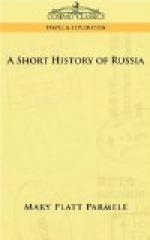But the passing illumination produced by the approach of Greek civilization did not penetrate to the region beyond, where was a tumbling, seething world of Asiatic tribes and peoples, Aryan, Tatar, and Turk, more or less mingled in varying shades of barbarism, all striving for mastery.
This elemental struggle was to resolve itself into one between Aryan and non-Aryan—the Slav and the Finn; and this again into one between the various members of the Slavonic family; then a life-and-death struggle with Asiatic barbarism in its worst form (the Mongol), with Tatar and Turk always remaining as disturbing factors.
How, and the steps by which, the least powerful branch of the Slavonic race obtained the mastery and headship of Russia and has come to be one of the leading powers of the earth, is the story this book will try to tell.
[1] In the Tatar language the word Ural signifies “girdle.”
CHAPTER II
SLAVONIC RELIGIOUS AND POLITICAL SYSTEMS
In speaking of this eastern half of Europe as Russia, we have been borrowing from the future. At the time we have been considering there was no Russia. The world into which Christ came contained no Russia. The Roman Empire rose and fell, and still there was no Russia. Spain, Italy, France, and England were taking on a new form of life through the infusion of Teuton strength, and modern Europe was coming into being, and still the very name of Russia did not exist. The great expanse of plains, with its medley of Oriental barbarism, was to Europe the obscure region through which had come the Hunnish invasion from Asia.
This catastrophe was the only experience that this land had in common with the rest of Europe. The Goths had established an empire where the ancient Graeco-Scythians had once been. The overthrowing of this Gothic Empire was the beginning of Attila’s European conquests; and the passage of the Hunnish horde, precisely as in the rest of Europe, produced a complete overturning. A torrent of Oriental races, Finns, Bulgarians, Magyars, and others, rushed in upon the track of the Huns, and filled up the spaces deserted by the Goths. Here as elsewhere the Hun completed his appointed task of a rearrangement of races; thus fundamentally changing the whole course of future events. Perhaps there would be no Magyar race in Hungary, and certainly a different history to write of Russia, had there been no Hunnish invasion in 375 A. D.
The old Roman Empire, which in its decay had divided into an Eastern and a Western Empire (in the fourth century), had by the fifth century succumbed to the new forces which assailed it, leaving only a glittering remnant at Byzantium.
The Eastern or Byzantine Empire, rich in pride and pretension, but poor in power, was destined to stand for one thousand years more, the shining conservator of the Christian religion (although in a form quite different from the Church of Rome) and of Greek culture. It is impossible to imagine what our civilization would be to-day if this splendid fragment of the Roman Empire had not stood in shining petrifaction during the ages of darkness, guarding the treasures of a dead past.




